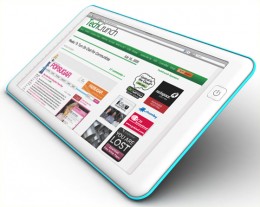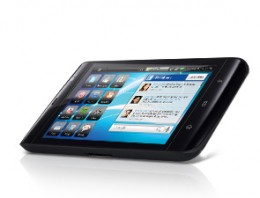
 CES was littered with “iPad killers” weeks before Apple even unveiled their long-rumored product. Tablets and slates were touted by HP, Sony, Lenovo, and many others as the next big thing: revolutionary products that would bring touch computing to the masses on large screens. These tablets were going to be full fledged laptops with the works – multiple USB ports, HDMI, SD slots – everything a gadget geek could possibly want. Steve Ballmer took the stage to give a keynote speech and held the HP Slate, in ebook mode, prominently displaying the cover of Twilight, which features an apple. It was the ultimate act of bravado and preemption by the PC world; they would strike first and not let Apple gobble up the tablet market the same way they conquered the mp3 player.
CES was littered with “iPad killers” weeks before Apple even unveiled their long-rumored product. Tablets and slates were touted by HP, Sony, Lenovo, and many others as the next big thing: revolutionary products that would bring touch computing to the masses on large screens. These tablets were going to be full fledged laptops with the works – multiple USB ports, HDMI, SD slots – everything a gadget geek could possibly want. Steve Ballmer took the stage to give a keynote speech and held the HP Slate, in ebook mode, prominently displaying the cover of Twilight, which features an apple. It was the ultimate act of bravado and preemption by the PC world; they would strike first and not let Apple gobble up the tablet market the same way they conquered the mp3 player.
Nearly eight months after the debut of the iPad, where is the competition? To be fair, it wasn’t until 2009 and the Motorola Droid that an Android phone really showed the iPhone what else was possible in the handset market. Today, the Evo, Droid X, Galaxy S series and Nexus One have made Android sexy. Are competing tablets going make this leap or will they undergo the same growing pains as the G1, a handset with promise that wouldn’t be fulfilled until the next generation?
 Michael Arrington championed the CrunchPad, his tablet computer concept which eventually became the JooJoo until literally the bitter end [Ed. I still want a CrunchPad]. When units finally shipped the storied tablet was underwhelming at best. Microsoft’s dual-screened Courier was cancelled before it even became a real product. The HP Slate has been on life support almost since Ballmer’s keynote concluded and the acquisition of Palm has only confused their plans. However, an HP tablet powered by WebOS tablet is now rumored to be released in Q1 of 2011. This bizarre state of affairs leaves us with an iPad that is selling at a rapid pace and an usual cast of characters left as the standard bearer for Apple alternatives: K-Mart and Dell.
Michael Arrington championed the CrunchPad, his tablet computer concept which eventually became the JooJoo until literally the bitter end [Ed. I still want a CrunchPad]. When units finally shipped the storied tablet was underwhelming at best. Microsoft’s dual-screened Courier was cancelled before it even became a real product. The HP Slate has been on life support almost since Ballmer’s keynote concluded and the acquisition of Palm has only confused their plans. However, an HP tablet powered by WebOS tablet is now rumored to be released in Q1 of 2011. This bizarre state of affairs leaves us with an iPad that is selling at a rapid pace and an usual cast of characters left as the standard bearer for Apple alternatives: K-Mart and Dell.
Much like the one ring in turning up in the Shire, an Android tablet has surfaced in the most unlikeliest of places: K-Mart. While 2GB of storage and 256MB of RAM might not sound like a lot, the tablet, made by Augen sells for just $150 – or $11 more than the Kindle. While there was some controversy about the inclusion of proprietary Google apps on the device without permission, the tablet is sure to excite based on price alone. However, lacking the official Google experience diminishes the potential of this tablet a bit.
 The Dell Streak has just made its American debut. While not technically a tablet because it also makes phone calls, it isn’t just a phone because it sports a spacious 5-inch screen. While it may look more 1980s than people want when held as a phone, using a headset could take care of that. Because it comes with an old version of Android, 1.6, but will soon be upgraded to 2.2, the hardware is well ahead of the software at the moment but once the update rolls out this could spawn a new class of smaller tablets.
The Dell Streak has just made its American debut. While not technically a tablet because it also makes phone calls, it isn’t just a phone because it sports a spacious 5-inch screen. While it may look more 1980s than people want when held as a phone, using a headset could take care of that. Because it comes with an old version of Android, 1.6, but will soon be upgraded to 2.2, the hardware is well ahead of the software at the moment but once the update rolls out this could spawn a new class of smaller tablets.
The other big player in the smartphone industry, RIM, is rumored to be working on a larger device called the BlackPad to compete head-to-head with the iPad. Rumored to have a 9.7-inch screen and a camera on each side the BlackPad would be competing in the right physical space, but like the Storm series of phones, lack the physical keyboard that makes RIM’s phones so beloved by the email obsessed. With their new OS and commitment to WebKit as a browsing technology, RIM might be able to make the jump, but as Apple and Google have shown with their phone: it’s about the apps.
With Apple updating the iPad to iOS 4 later this year and likely to announce a new iPad in January 2011, modeling the annual update cycle the iPod and iPhone have followed, the window for new tablets to grab a share of the market held by iPad 1.0 could be closing.
Get the TNW newsletter
Get the most important tech news in your inbox each week.




